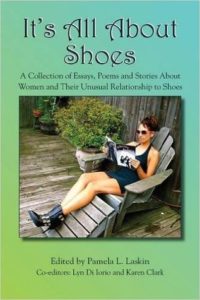 Review by Kerry Neville
Review by Kerry Neville
– If clothes make the man, then shoes, according to It’s All About Shoes, make the woman. This book, subtitled, A Collection of Essays, Poems and Stories About Women and Their Unusual Relationship to Shoes, examines the emotional but serious relationship women have with footwear, from three-and-one-half inch “black satin spike heels” to ergonomic “Earth shoes”; from “lotus shoes” once used in Chinese foot binding to combat boots that “soak up blood” in Iraq. The collection is divided into three parts: “The Past,” “The Present,” and “Coda: Thoughts for the Future.” “The Past” often addresses the mother-daughter dynamic as understood through shoes. “The Present” considers women and their identity vis a vis their shoes. “Coda” contends with aging feet and having to choose orthopedically practical shoes over beautiful, impractical ones. In the “Introduction,” Laskin writes, “a woman may look to her shoes as a means of either declaring or disguising her essential self, as well as her most secret wishes and desires” (11). A shoe is not superficial, but is the glass slipper that offers transformation.
The “Introduction” catalogues many fairytales that focus on shoes: “The Red Shoes,” “Cinderella,” “The Twelve Dancing Princesses,” and “The Shoemaker and the Elves”; these stories, imbedded in maturing imaginations, depict shoes both as agents of transcendence and deformity. In the opening essay of “Part I: The Past,” “Dreams at the Tips of My Toes,” Laskin acknowledges her feet, ugly now due to genetics; she wakes from a nightmare about “the hideous toenails that dress my mother’s feet” and imagines the curled, uncut nails as “fifty feet long” (15). “The Dreams Inside the Women’s Shoes” tells the story of Mortaz’s Iranian grandmother and aunts, and their superstitions regarding shoes, particularly shoe dreams where they would “dream about lost, formed, mismatched, broken-heeled, tight-fitting or loose pairs of shoes” (24). Shoes hold imaginative and divinitive sway in this house, though the narrator, in rebellion, buys a pair of white tennis shoes that she wears to a funeral and on her romantic dates. She has no shoe dreams, but owns the perfect shoes. While the children and adolescents in “Part I” are x-rayed for proper shoe fit, long for “lengthened and shapely” legs, and learn the performative power of a spike heel, they often choose oxfords, Converse sneakers, and Doc Martens as extensions of personality.
“Part II: The Present” initiates the reader into adult desire. In, “If the Shoe Fits, It Isn’t Sexy,” Clark recounts her stilettos worn only in bed for her husband, and describes a friend’s shoe resale business on Ebay where there is a “thriving market for ripe, stinky ladies’ shoes” (97). “Footprints and Shoes,” by Fix, examines the gruesome process of Chinese footbinding; a museum display case showcases the groom “gifted with a box of shoes and instructions on how to have sexual intercourse and foreplay with the bride, starting with massaging her stunted feet”(100-101). This tension between a cultural ideal of beauty and its disfigurative pain is teased out by Goehring-Plosky in, “Red Sole Canvas,” where she depicts the power of a high heel: “Catapulted to supermodel stature, I am at my sexiest, yet the accompanying narcissism makes me feel simultaneously self-conscious”(115). Like footbinding, high heels warp a foot’s bone structure, causing bunions and stress fractures in the name of beauty and power.
“Part III Coda” opens with an image of shoes collected for Haitian earthquake victims: practical and necessary need over fleeting, superfluous lust. In, “Stilettos and Power: What I Did for… Love? Money? Power?,” Youner catalogues what women will do to force their feet into shoes that don’t resemble feet (injectable fillers, surgeries, toe shortening); “Be kind to your body,” she writes. “It will thank you” (162). Minnich comments in, “Those Look Comfortable,” that high heels “are not meant to carry the weight of a human being” (163). Morris in “New Balance,” a former high heel enthusiast, is almost permanently disabled after a shattered fibula, and states, “[A]fter an accident like this, your foot doesn’t remember its relationship to the ground” (168). Her New Balance sneakers help her to come to terms with both the unsteady ground beneath her feet and time’s steady passage through them. “The Future,” by Laskin, ends the collection where it begins: in a fairytale. We are given a vision of a “shoeless universe” where everyone “prances around in bare feet,” on a “Green planet”(177). The dancing girls with their bloodied feet have vanished.
It’s All About Shoes: A Collection of Essays, Poems and Stories About Women and Their Unusual Relationship to Shoes
Edited by Pamela L. Laskin; Co-editors: Lyn Di Iorio and Karen Clark
Plain View Press, LLC 2015
Trade Paper 188 pages
ISBN: 978-1-63210-012-2
Kerry Neville is the author of the short fiction collection, Necessary Lies, winner of the Sharat Chandra Award. She received the Dallas Museum of Arts, “Arts and Letters Live,” Fiction Prize, and the Texas Institute of Letters Short Story Prize. Her fictions and essays have appeared in many journals.
